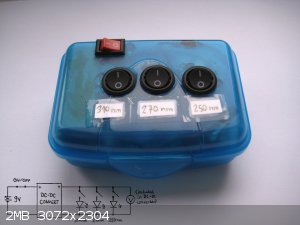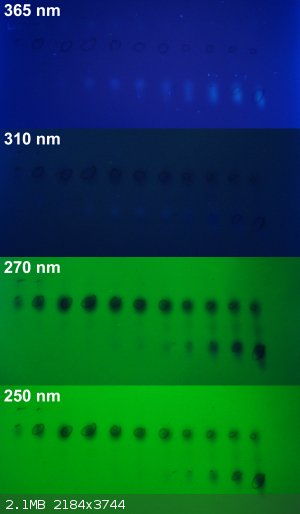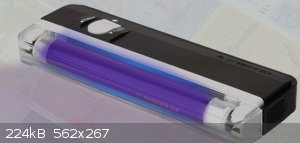Diachrynic
Hazard to Others
  
Posts: 219
Registered: 23-9-2017
Location: western spiral arm of the galaxy
Member Is Offline
Mood: zenosyne
|
|
Cheap DIY TLC lamp
I recently build a handheld TLC visualizer and I am quite happy with how it turned out, so I thought I'd share some insights that I gained.
The device consists of a 9 V battery, connected to a switch and a DC-DC buck/boost converter with current and voltage control. The output is then fed
to the LEDs. I used three different wavelengths, gave each of them a switch and wired them in parallel - however only one of them can be turned on at
a time. I think for a TLC visualizer only a single UV-C LED is needed.
For my lamp I used 1 W LEDs of 250, 270 and 310 nm. They have a forward current of 150 mA and require 5-8 V. I set the current limit on my DC-DC
converter to 130 mA and voltage limit to 6.2 V in order not to run at specification limit. At this current the LED draw about 0.75 W.
Having tested 250, 270 and 310 nm LEDs I can say that both 250 and 270 nm ones work very well for visualizing. The plates glow brighter with 250 nm,
but I find that I can actually see the spots slightly better when using 270 nm. I am not quite sure why that is. I can't quite decide which ones I
like more, but the 270 nm LEDs were quite a bit cheaper. 310 nm don't work to any appreciable degree to excite the indicator in the silica. I bought
my LEDs from this eBay listing.
My LEDs have a 60° beam angle and at the time of writing cost me about 10$ for the 270 nm one and about 20$ for the 250 and 310 nm ones each. I was
pleasantly surprised these UV-C LEDs are actually what they claim to be.
You can replace my DC-DC converter with one that doesn't have current control, but then I wouldn't recommend wiring several LEDs with switches in
parallel, as they can differ in their voltage/current demands. But it does work for a single LED. Check the voltage/current with a multimeter when
dialing in the potentiometer.
I didn't put any effort in cooling and just relied on the copper baseplate my LEDs came with as I don't intent to run my lamp for extended periods of
time. (If you are looking for UV leds for photoreactions I think some way of cooling would be a good idea.)
When building the box I found using a soldering iron a great way to cut holes into the polypropylene plastic box. The molten plastic can be wiped on
tissues, this way it doesn't char at all and only smokes a bit. The LEDs sit on the underside of the box and peek through small holes in the plastic.

Here is a picture of a F254-TLC plate with a commercial 365 nm UV torch + ZWB2 filter and all the different UV LEDs. (The TLC shows
fractions from a failed chromatography.)

Using only a 270 nm LED, a DC-DC converter without current control, some cables, a switch and some form of housing one of these lights could be
constructed for about 20-25$ in material costs total.
we apologize for the inconvenience
|
|
|
Oxy
Hazard to Others
  
Posts: 140
Registered: 1-12-2020
Member Is Offline
|
|
This is nice.
I have mine even cheaper, considering both: the time and money.
I bought 2 banknote testers which have a small UV lamp ~365 nm.

For one of them I bought UV-C light source that provides a 254nm length
https://www.osram.com/ecat/PURITEC%20HNS%20UV-C-UV-C%20lamps...
Now I have 2 convenient UV sources with 254 and 365 when needed.
It all costed me approx 10$, didn't need to do anything more than removing the plastic bulb cover and replace the light source 
|
|
|
Diachrynic
Hazard to Others
  
Posts: 219
Registered: 23-9-2017
Location: western spiral arm of the galaxy
Member Is Offline
Mood: zenosyne
|
|
This is a great option too! I didn't think there were cheap low pressure Hg lamps that would fit these.
I would recommend some sort of cover to avoid being hit by the UV-C directly though. This was the issue I had with my previous TLC lamp
(unidirectional emission), which was also just a low pressure Hg lamp in a lamp fixture - but it ran from wall power. Yours is more convenient in this
regard for sure.
we apologize for the inconvenience
|
|
|
Oxy
Hazard to Others
  
Posts: 140
Registered: 1-12-2020
Member Is Offline
|
|
I was looking for some visualisation lamp and was shocked when saw prices of professional lamps.
I then realized that there are UV-based devices for aquarium water treatment and started looking for something suitable.
As for the cover - this is right. Most often I use the lamp in the hood standing covered by the sash window, wearing protective googles and wearing
gloves and coat to protect myself from UV.
By the way, I also found a chinese UV LED 4W it was much more intense and I didn't want to use that for TLC. That one may be good for radical
halogenations or others that require some energy.
|
|
|
Mateo_swe
National Hazard
   
Posts: 501
Registered: 24-8-2019
Location: Within EU
Member Is Offline
|
|
Does a 410nm UV flashligt work for TLC visualizations?
|
|
|
Oxy
Hazard to Others
  
Posts: 140
Registered: 1-12-2020
Member Is Offline
|
|
It depends on the substance I guess. If the substance you try to visualize fluoresces under the light of this wavelength (and the plate doesn't) then
it will be usable. Or if this substance absorb the light of this wavelength but the plate is excited, then you would see dark spots.
But I would rather stick to 254nm as this is the wavelength that this is very likely to be absorbed by many of organic compounds and it's very easy to
buy TLC plates coated with UV active substance that fluoresces under 254nm. I am not sure about the absorption/emission under 410nm
|
|
|
Mateo_swe
National Hazard
   
Posts: 501
Registered: 24-8-2019
Location: Within EU
Member Is Offline
|
|
I ordered 2 pcs of UV-C 270nm 1W LEDs and a DC-DC converter max 300ma from the same EBAY seller as Diachrynic did buy from.
I easily DIY together a simple TLC lamp from these and save one of the LEDs as a future spare/replacement.
Thanks for the info.
|
|
|